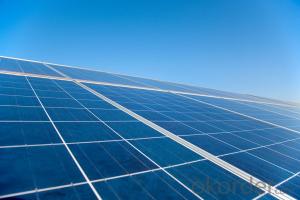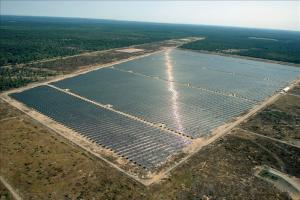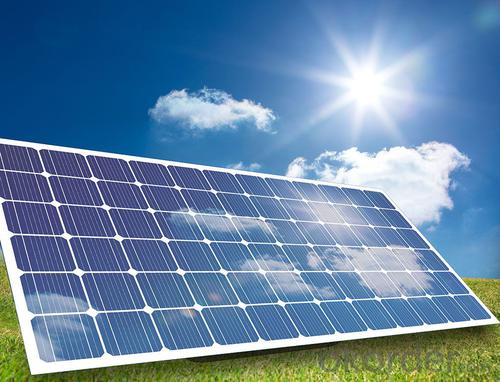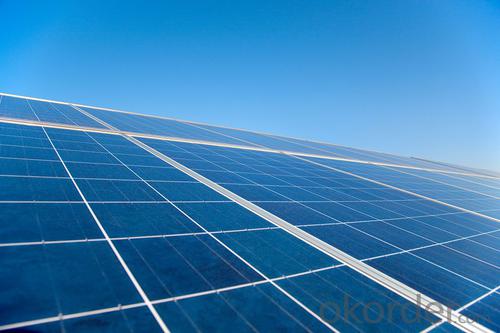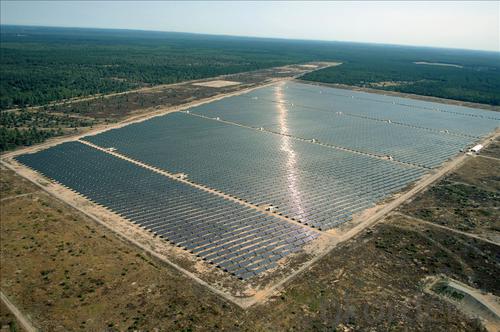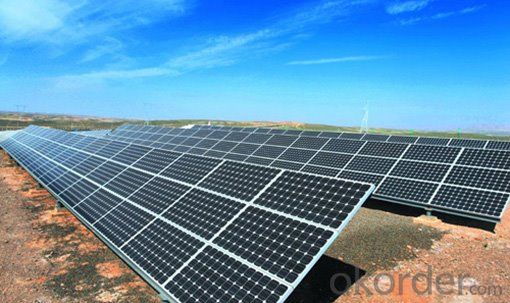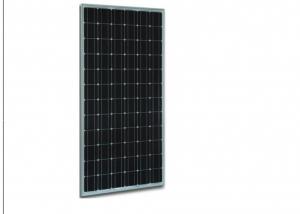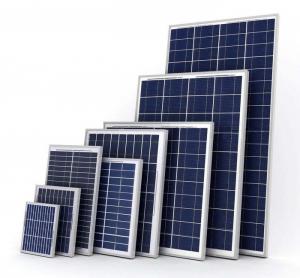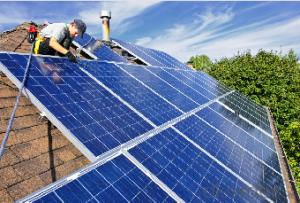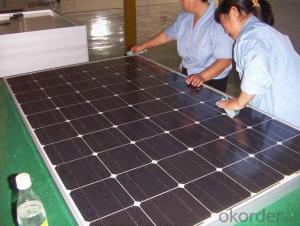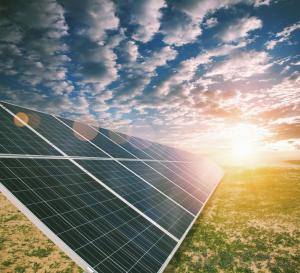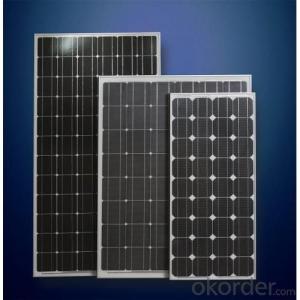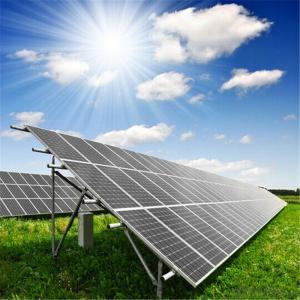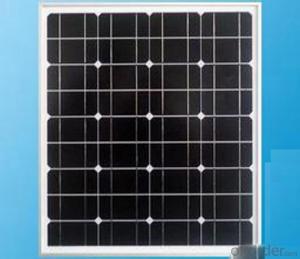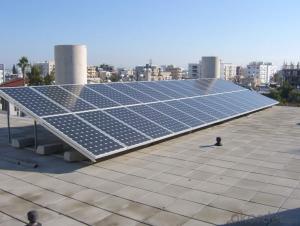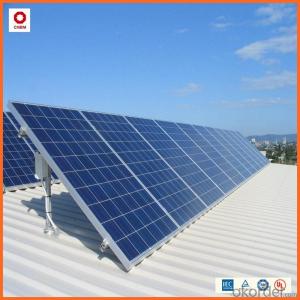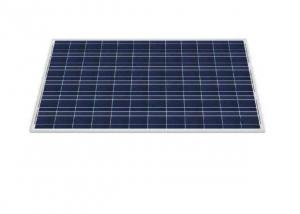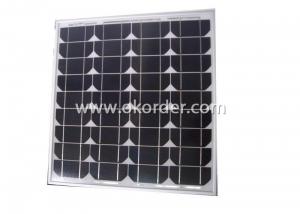250w 260w Monocrystalline Solar Panel Solar Module, TUV Certified
- Loading Port:
- Shanghai
- Payment Terms:
- TT or LC
- Min Order Qty:
- 100 watt
- Supply Capability:
- 111111 watt/month
OKorder Service Pledge
OKorder Financial Service
You Might Also Like
1.Structure of Solar Module Description
Solar panel refers either to a solar hot water panel, a common type of a solar thermal collector, or to one or more solar photovoltaics (PV) modules, electrically connected and mounted on a supporting structure.
A PV module is a packaged, connected assembly of typically 6×10 solar cells. Solar PV panels constitute the solar array of a photovoltaic systemthat generates and supplies solar electricity in commercial and residential applications. Each module is rated by its DC output power under standard test conditions, and typically ranges from 100 to 320 watts. The efficiency of a module determines the area of a module given the same rated output – an 8% efficient 230 watt module will have twice the area of a 16% efficient 230 watt module. There are a few solar panels available that are exceeding 19% efficiency. A single solar module can produce only a limited amount of power; most installations contain multiple modules. A photovoltaic system typically includes a panel or an array of solar modules, an inverter, and sometimes a battery and/or solar tracker and interconnection wiring.
2.Main Features of the Solar Module
1).High conversion efficiencies resulting in superior power output performance.
2).Outstanding power output even in low light or high temperature conditions
3).Optimized design for ease of soldering and lamination
4).Long-term stability,reliability and performance
3.Solar Module Images
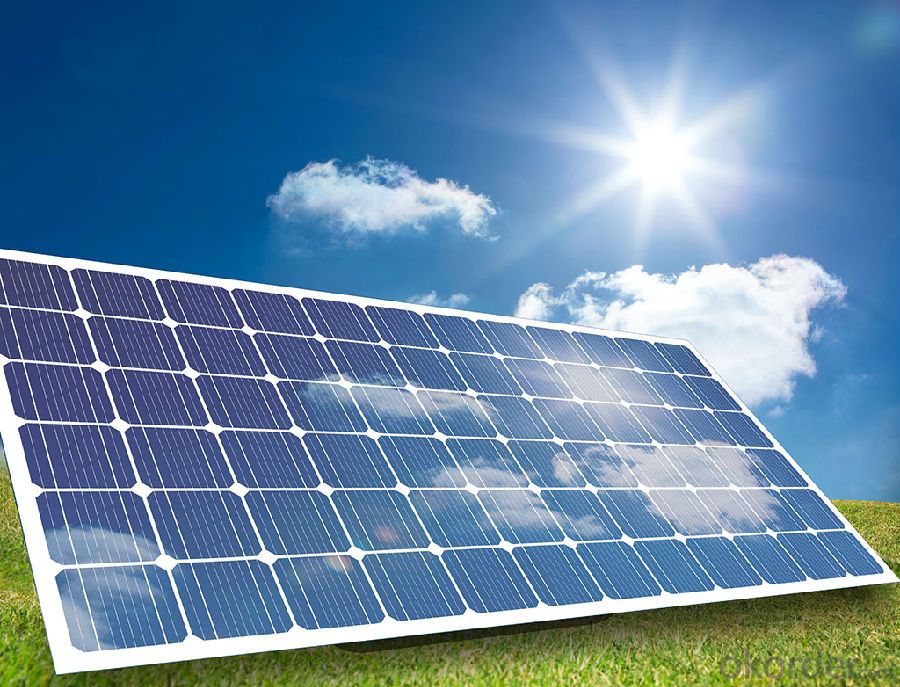

4.Solar Module Specification
Specifications
Features:
Aesthetic appearance with excellent efficiency based on innovative
photovoltaic technologies
Strong frame, passing mechanical load test of 5400Pa, instead of the normal
2400Pa,to withstand heavier snow load and higher wind-pressure
Warranties:
10 years limited product warranty
15 years at 90% of the minimal rated power output
25 years at 80% of the minimal rated power output
Specificate sheet:
5.FAQ of Solar Module
1). Q: Are you a factory or trading company?
A: We are a factory.
2). Q: Where is your factory located? How can I visit there?
A: Our factory is located in Jiangyin, Jiangsu, China, near Shanghai. You are warmly welcomed to visit us!
3). Q: How can I get some samples?
A: Please connect me for samples
4). Q: Can the price be cheaper?
A: Of course, you will be offered a good discount for big amount.
- Q: The first panel is located in New England, the second is placed in the Sahara desert, the third is on the Earth side of the moon, and the last is on the far side of the moon. Which panel would absorb the most sunlight over a year's time and why ? All the panels are place in optimal places where they would get the most light available.
- Best to worst: far side of the moon, near side of the moon (same as far side, except for lunar eclipses), Sahara desert (not at 0 latitude, and occasional bad weather), New England (less favorable latitude, and LOTS of bad weather).
- Q: Can solar panels be installed on schools or universities?
- Yes, solar panels can definitely be installed on schools or universities. In fact, many educational institutions are increasingly adopting solar energy as a sustainable and cost-effective solution to meet their electricity needs. By installing solar panels, schools and universities can reduce their carbon footprint, save money on energy bills, and provide a valuable educational opportunity for students to learn about renewable energy.
- Q: is a wind turbine better than solar panels
- solar water heater and solar power system.
- Q: Does anyone know how I would go about hooking up the air conditioners in my house to solar panels? I would want just the air conditioners to be powered by solar energy. How could I hook it up where the panels can absorb energy from the sun during the day, and save and store the energy so I can run the air conditioners at night? I really feel that in the long run, this would save a lot of money with the energy bill. It's the use of the air conditioners that drive up the bill. Is this idea feasible? Is it also possible to have some sort of hybrid system where I can switch from solar to my regular local energy source when I want to?
- There's no need to connect only the A/C to solar, nor is there a need to use batteries. Both of those problems are solved with grid-tied solar. The solar electricity system works alongside your regular, and the A/C just plugs in normally. You never need to worry about switching. During the day, if the A/C is drawing power, the solar goes into that, reducing your draw from the electric company. If the solar generates more than the A/C needs, the meter is driven backwards. At night, the meter runs forward again. For example, the meter may read 5000 in the morning. By evening, maybe it reads 4975. At night, it creeps back up to 5005. When the meter reader comes, you would be billed for only 5 kWh. That's the general idea. Also, consider whether you can insulate your home more, and whether you might want to change out your air conditioners for new, DC inverter mini-split units. Those can use a fraction of the electricity per BTU of regular air conditioners.
- Q: I'm part of the Sustainability group at school, the school principal is a d**k and doesn't care about the environment, he only cares about money.Me and the group will be talking in front of him and the school council (the people in-charge of the school's money) To convince them to put solar panels on the school roofs.I know that it definitely will help the school save on electricity bills, but it WILL cost a lot of money to put them in.In the end we just wanna reduce carbon emissions!HELP :)
- When okorder / Good luck but the best way to win is to find a way to get it done and then they can't say no.
- Q: Can solar panels be installed on a parking lot or carport?
- Yes, solar panels can be installed on a parking lot or carport. In fact, this is a growing trend known as solar carports or solar parking lot canopies. These structures not only provide shade for vehicles but also generate clean and renewable energy. They are a great way to utilize unused space for solar power generation while providing additional benefits such as reducing heat island effect and offering covered parking.
- Q: I want to build a Solar Panel at home.Where can I find possibilities for Selfmade Solar Panels
- that will sell a ready-made panel for less than that. Note that when someone puts up free instructions, they usually have lots of pictures of themselves and what they made, step-by-step. What I have noticed in all of the review sites for solar guides is that they never have a picture of what they made, in spite of their claims to have tried the guide. At best, all I see is stock pictures from the guide.
- Q: hi guys, i need help, okay lets say i decide to put solar panels near a place where its inhabitated by people, what kinda of environmental factors should i consider? Will the solar panels cause any damage to the enviromnent around it? Will it affect the plant and animals around it? should i consider the weather? its for my class so if u guys can help thankx.
- You would need to consider how much sun your area gets on average. You would need to do a cost/benefit analysis to decide if you will be saving money eventually. Environmentally, it would not affect the plants or animals around it, except those it might block the sun from. Meaning, the grass growing in the shade of the panels will probably die out, but that goes for anything that would cast shade for the majority of the time. Solar panels are simply rechargers for the batteries it's hooked up to. No different than a cell phone charger affects the area, people or plants around it. If it is a worry, make some orgonite and place it around the panels. :)
- Q: i was reading the popular science magazine and i saw that they might make a Sun Powered it Absolutely NOT possible to make a car with a Solar Panel? I dont see any harm in making it..
- How would a car with Solar Panels work in a city like London, Seattle, or Dublin, where it is cloudy and rainy more often than not? Unless there is a way to store up the solar power, I don't see it working very well.
- Q: How could I find out what the amp output of a solar panel? Specifically, I want to know how many milliamps can the solar panel on a Casio fx-260 put out?
- You need full sunshine from the sun, or a lamp that will give a light spectrum similar to the sun, a volt meter, Milli-amp meter, and a variable resistor of 0 to 000 ohms. The voltmeter test leads go across the solar cell leads. The amp meter leads will be in series with the solar cell. Let's say, positive lead of the solar cell to the the positive lead of the amp meter, the negative lead of the amp meter to one terminal of the variable resistor, and the wiper terminal of the variable resistor to the negative lead of the solar cell. Slowly decrease the value of the resistor until the voltage from the solar cell just begins to drop. Take note of the amp meter reading. This is about the high end range of the solar cell. You might want to begin with a micro-amp meter for the current meter.
Send your message to us
250w 260w Monocrystalline Solar Panel Solar Module, TUV Certified
- Loading Port:
- Shanghai
- Payment Terms:
- TT or LC
- Min Order Qty:
- 100 watt
- Supply Capability:
- 111111 watt/month
OKorder Service Pledge
OKorder Financial Service
Similar products
Hot products
Hot Searches
Related keywords


